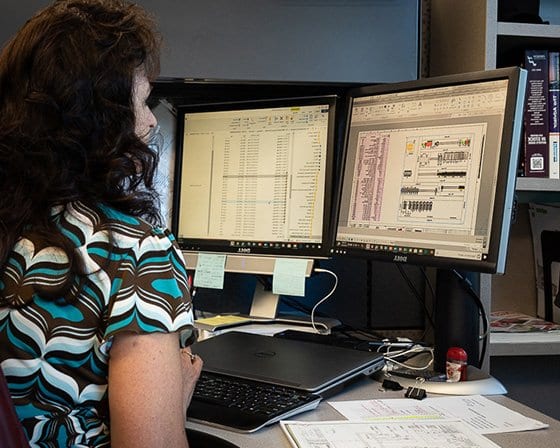
Many companies spend time and resources for fully defined P&IDs, while other companies only utilize preliminary block flow diagrams. No matter where you land on the scale, this article will highlight real-world examples of the information you need and what a process system designer can do for you. You will be able to determine what level of effort will be required to take your process technology to a fully installed process system.
The questions weighing on the minds of companies we talk to are these:
- How much is it going to cost?
- How will it work?
- What equipment will it take to work?
- How long will it take to build?
There are instances where these questions can be answered easily. Other times, it takes a tremendous level of effort to arrive at the answers to these questions. The answers to these questions, in almost every case, precede the design/build effort of your system.
The amount of engineering effort required by a process system designer, prior to final design/build, hinges on two main factors:
- The completeness of your process design documentation
- The level of fidelity required to advance your project
See the below cases to understand the relationship between these two factors and how they play out when developing your process system.
Case 1: Overview: Company A is part of the research and development (R&D) group for a leading chemical company. They have been tasked with determining if there is a strong return on investment (ROI) for a system that can recover solvent out of a waste stream. The company has proven that they can accomplish the separation at the lab scale and have developed a preliminary PFD.
Solvent costs are understood, and they know the costs associated with disposal. What they don’t know is how much the system will cost and the total operating costs. To submit their capital request, they need to understand the approximate cost of the system, schedule and operating costs.
- Current Process Design Documentation:
- Preliminary PFD’s
- Preliminary process description (they have proven their process technology in a lab setting)
- Level of Fidelity Required to Advance Your Project:
- Company A requires a budgetary cost estimate
- Level of Engineering Required to Advance Your Project:
- Heat and material balance development
- All equipment identified and sized with defined materials of construction (MOC)
- Instrumentation type and counts identified
Conclusion: “Company A” brought the process systems team preliminary PFD’s and a process description that had been proven at the lab scale. They required a budgetary cost estimate, operating costs, and a preliminary schedule.
To deliver a cost estimate with a clear basis, most process system designers will require that they, or the final customer, first develop the following:
- Heat and material balance equipment list with preliminary sizing and MOC
- Preliminary equipment list with instrument counts
Complete engineering documentation allows a process system designer to assemble a budgetary estimate that is based on real world equipment. However, if that base documentation does not exist, process system designers often propose a small amount of pre-engineering to develop the lacking documentation.
Case 2: Company B is part of an internal engineering team for a leading consumer products company. They have funding and a budget for the total cost of their production expansion. New product expansion requires more automation and has several additional ingredients that must be dosed with a high level of accuracy.
“Company B” has a strong internal engineering group, but are already overburdened by a multitude of projects. Therefore, management decided to subcontract the project to a turnkey process system design/build company. Corporate is requiring that they solicit a fixed bid, and has allocated engineering pre-spend to develop the engineering to a point that a fixed bid can be delivered- mitigating contingency due to unknowns.
- Current Process Design Documentation:
- Complete PFD
- Written Process description
- Heat and material balance
- Equipment list with sizing and MOC
- Detailed instrument list
- Level of Fidelity Required to Advance Your Project:
- “Company B” requires a fixed bid for the total installed cost (TIC) for the entire project
- Level of Engineering Required to Advance Your Project:
- Final process description
- Final design basis
- Final PFD
- Final heat and material balance
- Utility summary
- Effluent summary
- Piping and instrumentation digammas (P&ID)
- Detailed equipment list
- Equipment sizing
- Process criteria
- Operational criteria
- Power loads
- MOC
- Final instrument list
- Preliminary 3D models developed
- Preliminary Equipment & Piping General Arrangement Drawings
- Identification of Design and Construction Codes
- Preliminary Transport Plan
- Preliminary Construction and Installation Plan
- Preliminary Automation Design Basis
- Motor & Electrical Devices List (MEDL)
- HAZID (Hazard Identification Meeting)
- Hazardous Area Classification Project Definition
Conclusion: “Company B” already completed a portion of the pre-engineering needed to drive their effort to a fixed cost and clear scope of work. Their documentation was the building block for the subsequent engineering required to develop a fixed cost for the system.
The company used their remaining pre-spend to have a process system designer advance the engineering to a point where a fixed project cost could be given. This effort allows the bidding firm to drive contingency (typically included for unknowns) out of the final price. At the end of this engineering effort, Company B had a fixed price for a well-developed scope of work, including approximately 30% of the engineering complete for the entire project.
Case 3: A large EPC is soliciting bids for, what they call, “Pre-Assemble Units” (PAU’s) for a new chemical plant they have been contracted to build. As an EPC, they have dedicated engineering teams developing detailed requests for quotes (RFQs) so they can get clear apples-to-apples pricing on each PAU. Their engineering documentation allows for zero degrees of freedom and has clear expectations for the process design build companies bidding on this scope. The EPC is subcontracting equipment specification, procurement, project management, fabrication, automation and commissioning of these individual PAUs to qualified design/build companies.
- Current Process Design Documentation:
- Complete PFD
- Written Process description
- Heat and material balance
- Equipment list with sizing and MOC
- Detailed instrument list
- Final process description
- Final design basis
- Final PFD
- Final heat and material balance
- Utility summary
- Effluent summary
- Piping and instrumentation digammas (P&ID)
- Detailed equipment list
- Equipment sizing
- Process criteria
- Operational criteria
- Power loads
- MOC
- Final instrument list
- Preliminary Equipment & Piping General Arrangement Drawings
- Identification of Design and Construction Codes
- Preliminary Transport Plan
- Preliminary Construction and Installation Plan
- Preliminary Automation Design Basis
- Motor & Electrical Devices List (MEDL)
- HAZID (Hazard Identification Meeting)
- Hazardous Area Classification Project Definition
- Level of Fidelity Required to Advance Your Project:
- EPC requires a fixed bid for final engineering, equipment specification, procurement, fabrication, automation and commissioning
- Level of Engineering Required to Advance Your Project:
- Little to no engineering is required to provide a fixed price for the PAU’s
Conclusion: In this case, the EPC developed the early stage engineering to a point that a fixed quote could be assembled without further engineering needed by a process system designer.
These cases are representative of clients we partner with on a day-to-day basis. Some customers are in the very early stages of project development (Case 1), and thus require more engineering to develop a project price and timeline. Others have complete engineering packages and have defined the scope so clearly that we can easily put a price to a turnkey system (Case 3). No matter where you are on this scale, experienced process design firms can guide you through the critical steps required to advance your project.
